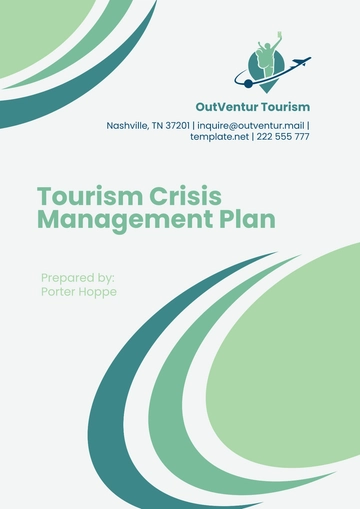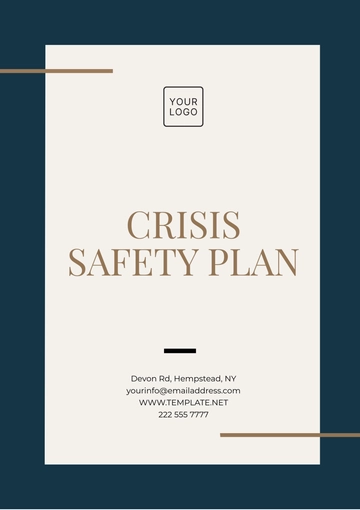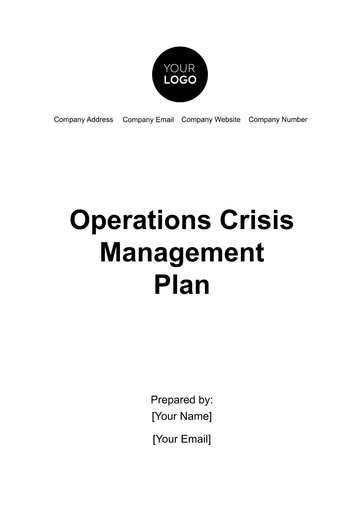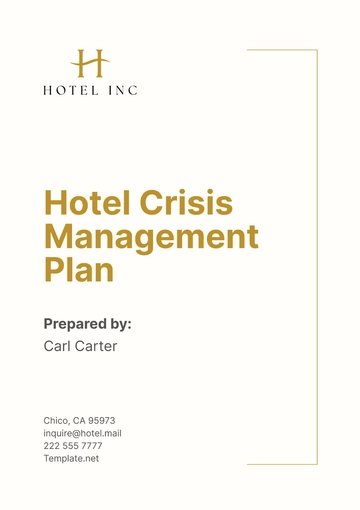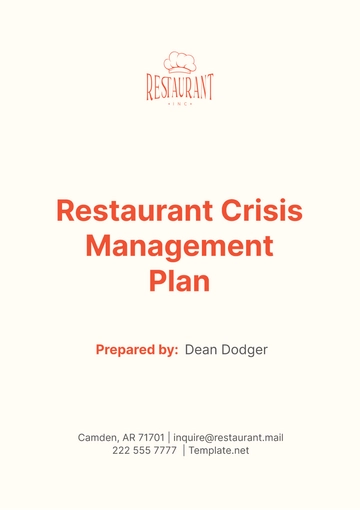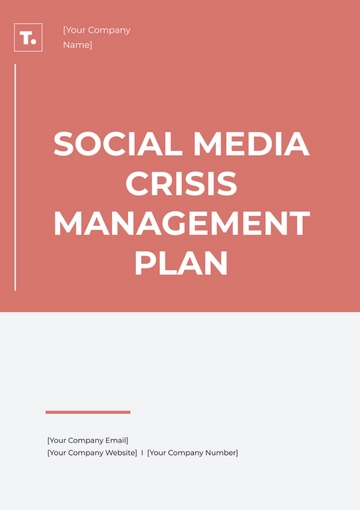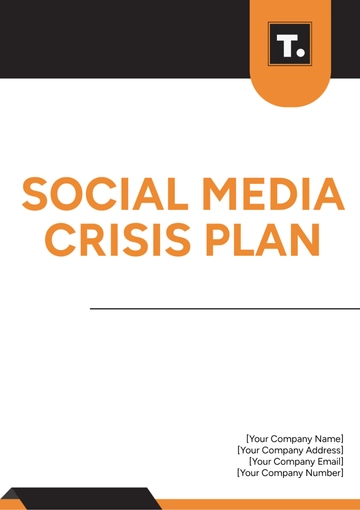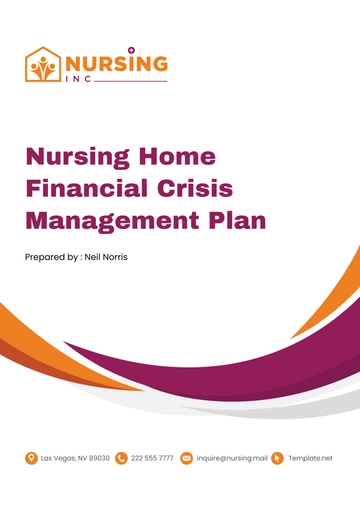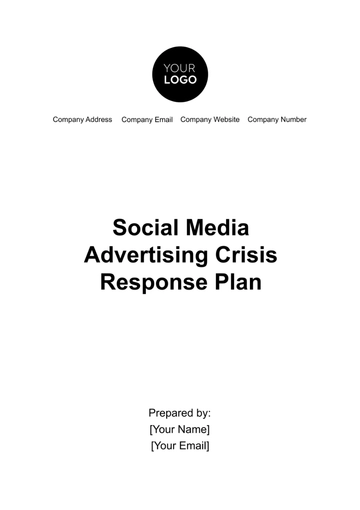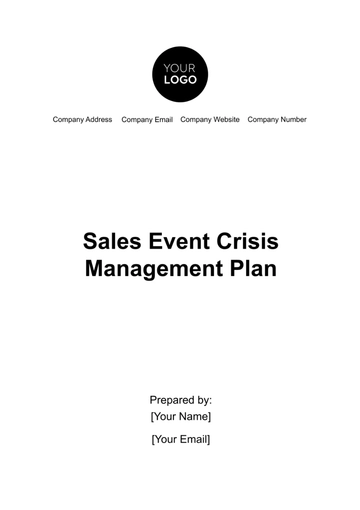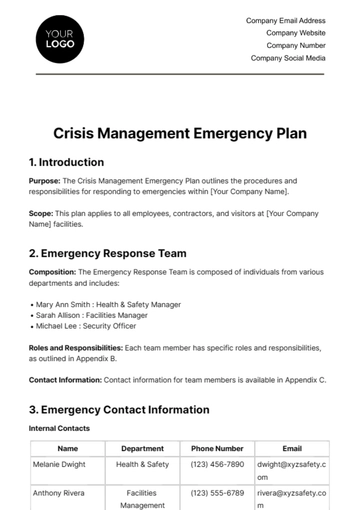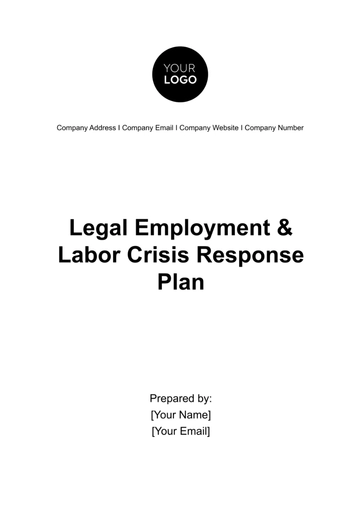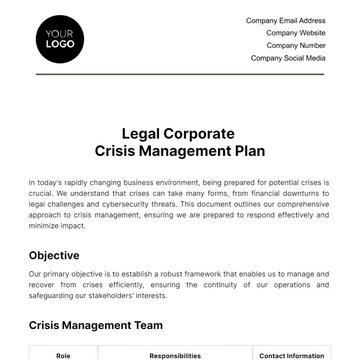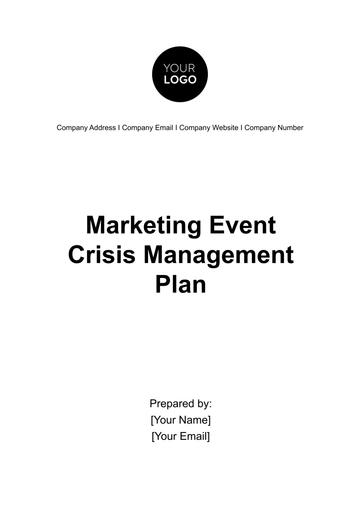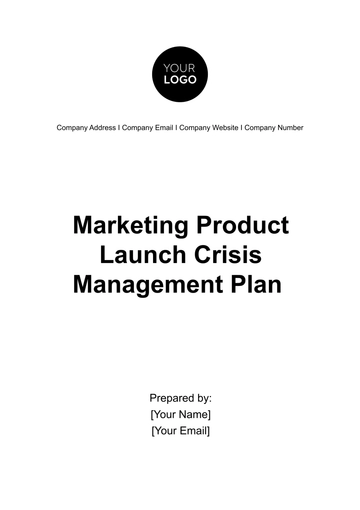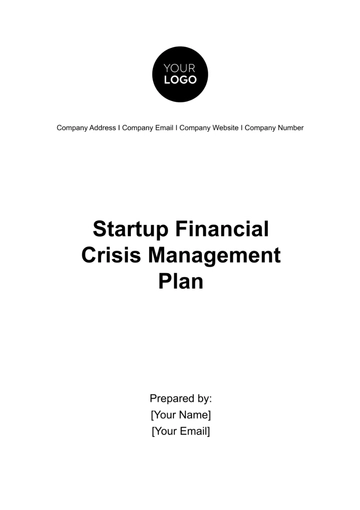Free Sales Event Crisis Management Plan
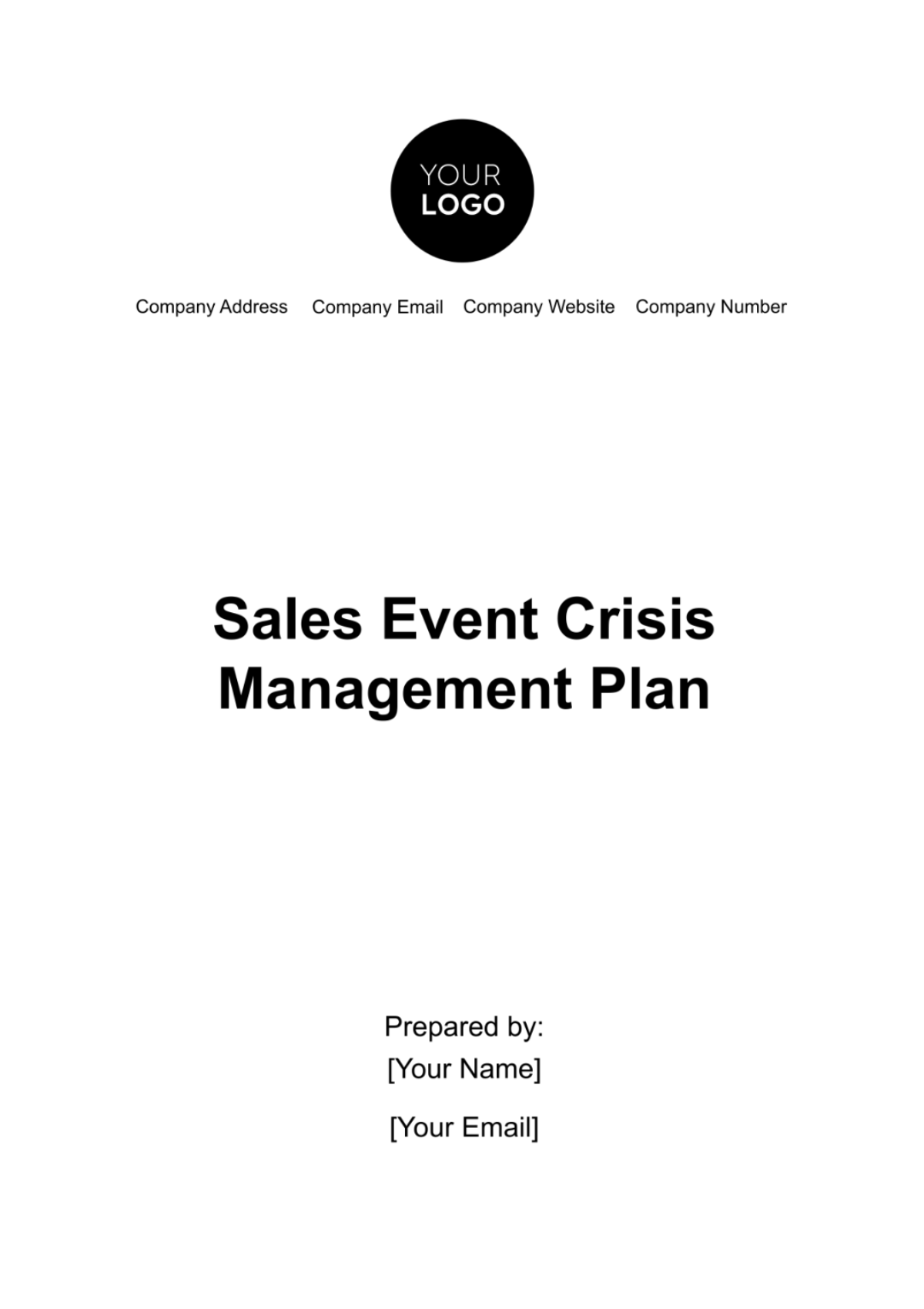
I. Introduction
A. Purpose Of The Plan
The plan is a pivotal document meticulously crafted to serve as a safeguard for the seamless execution of our sales events. It is designed to provide a structured and proactive approach to crisis management, ensuring that unexpected challenges and disruptions are met with efficient and effective responses. By addressing potential crises head-on, this plan aims to uphold the integrity of our brand, protect our event's success, and maintain customer trust.
B. Scope And Objectives
This comprehensive plan encompasses a wide array of potential crisis scenarios, ranging from technical hiccups to supply chain disruptions, and from security breaches to market fluctuations. Its scope extends to all facets of our sales events, ensuring that our response strategies are adaptable and resilient. The primary objectives of this plan include:
Minimizing the impact of crises on the event's operations.
Safeguarding the well-being of our customers, employees, and partners.
Maintaining clear and effective communication with both internal and external stakeholders.
Preserving the reputation and integrity of our organization and its events.
C. Key Stakeholders
The success of this plan relies on the coordinated efforts of various stakeholders who play pivotal roles in the event's execution and crisis response. Key stakeholders include, but are not limited to:
Event Organizers and Management
Technical Support and IT Teams
Customer Service Representatives
Public Relations and Communications Specialists
Legal and Compliance Experts
External Partners and Vendors
This document serves as a guide for these stakeholders, equipping them with the knowledge and procedures required to navigate the complexities of a crisis and ensure a swift return to normalcy during our sales events.
II. Event Overview
A. Description Of The Sales Event
[Your Company Name] Sales Event, [Event Name] is a prominent annual marketing initiative designed to showcase our latest products and offerings to a diverse customer base. The Event serves as a vital platform for brand promotion and revenue generation. Here are the details of the event:
Event: | [Event Name] |
Date: | [Month Day, Year] |
Venue: | [Event Venue] |
Theme: | Cutting-Edge Technology Showcase |
Target Audience: | Consumers, B2B Clients, and Industry Partners |
Expected Attendance: | 5,000 Attendees |
B. Event Goals And Targets
The primary objectives of [Event Name] are to:
Promote New Products: Introduce and create buzz around our latest product offerings.
Generate Sales: Drive immediate and future sales through exclusive discounts and incentives.
Enhance Brand Visibility: Strengthen brand presence and awareness in the market.
Network And Partnerships: Foster relationships with industry partners and potential collaborators.
Customer Engagement: Provide a memorable and positive experience for attendees.
C. Event Timeline
The event is a multi-day affair, carefully structured to maximize impact and engagement. Below is an overview of the event timeline:
Day 1: Opening Ceremony And Product Launch
Morning: Registration and Welcome Breakfast
Afternoon: Grand Opening Ceremony
Evening: Exclusive Product Launch and Reception
Day 2: Sales And Demonstrations
Morning: Product Demonstrations
Afternoon: Sales Booths
Evening: Workshops
Day 3: Networking And Closing
Morning: B2B Networking Sessions
Afternoon: Customer Appreciation Activities
Evening: Closing Gala and Awards Ceremony
The timeline is subject to minor adjustments based on operational requirements and customer feedback. Throughout the event, meticulous planning and crisis management will be in place to ensure a seamless experience for attendees and address any unforeseen challenges that may arise.
III. Risk Assessment
A. Identification Of Potential Risks
In this critical phase of risk assessment, a comprehensive analysis of potential challenges and threats that may jeopardize the success of the sales event must be conducted. These potential risks are not limited to but encompass:
Technical Vulnerabilities: Identification of weaknesses in our digital infrastructure, including website crashes, payment processing issues, and data security breaches.
Supply Chain Disruptions: Analysis of vulnerabilities within the supply chain, including potential shortages, logistical hiccups, or vendor-related complications.
External Factors: Evaluation of external influences such as adverse weather conditions, natural disasters, and unforeseen market fluctuations that could impact the event.
Operational Challenges: Examination of potential operational difficulties, including staffing issues, overcrowding, and compliance with local regulations.
B. Risk Analysis And Prioritization
Once potential risks are identified, a rigorous risk analysis process will take place to assess their impact and likelihood. This analysis will include:
Impact Assessment: A thorough evaluation of the potential consequences associated with each risk, considering financial, reputational, and operational implications.
Likelihood Assessment: The determination of the probability of each risk occurring, taking into account historical data and expert insights.
Risk Prioritization: Risks will be categorized into high, medium, or low priority based on their assessed impact and likelihood. High-priority risks will demand immediate and focused attention.
C. Risk Mitigation Strategies
To mitigate the identified risks, a proactive approach will be adopted, involving the development of mitigation strategies that align with the risk priorities. These strategies will include:
Contingency Plans: Clearly defined contingency plans will be established for each high-priority risk, outlining the steps to be taken in the event of their occurrence.
Preventative Measures: Preventative measures will be implemented to reduce the likelihood of risks, such as enhanced security protocols, redundant systems, and strategic vendor partnerships.
Monitoring And Early Warning Systems: Continuous monitoring and early warning systems will be put in place to detect signs of potential crises and allow for swift response.
Resource Allocation: Adequate resources, including human resources, technology, and financial reserves, will be allocated to support risk mitigation efforts.
This thorough risk assessment is a foundational element of our Sales Event Crisis Management Plan, enabling us to proactively identify, evaluate, and address potential threats, ultimately safeguarding the success and reputation of our sales event.
IV. Crisis Team
The Crisis Team is a critical component of the Sales Event Crisis Management Plan. It consists of a group of dedicated individuals with specific roles and responsibilities aimed at efficiently and effectively managing crises that may arise during the sales event. The team is responsible for coordinating the response, making critical decisions, and ensuring the event's continuity in challenging situations. Each team member is selected based on their expertise and experience related to potential crisis scenarios.
A. Roles And Responsibilities
The following table outlines the key roles and responsibilities of the Crisis Team members:
Role | Responsibilities |
Event Coordinator | Overall event leadership, decision-making, and crisis management. |
Technical Expert | Addresses technical issues, system failures, and IT-related crises. |
Customer Liaison | Manages customer communications and addresses their concerns. |
Public Relations | Handles media relations and public statements in crisis situations. |
Security Officer | Ensures event security and addresses security breaches. |
Supply Chain Manager | Manages product shortages and supply chain-related crises. |
Legal Advisor | Provides legal guidance and ensures compliance with regulations. |
B. Chain Of Command
In the event of a crisis, a clear chain of command is established within the Crisis Team to facilitate efficient decision-making and response. The chain of command is as follows:
Event Coordinator: The Event Coordinator has the ultimate authority and responsibility for crisis management decisions.
Technical Expert, Customer Liaison, Public Relations, Security Officer, and Supply Chain Manager: These team members provide expertise and support to the Event Coordinator, offering recommendations and executing tasks within their areas of responsibility.
Legal Advisor: The Legal Advisor offers legal counsel to ensure that all actions taken during the crisis are compliant with relevant laws and regulations.
Establishing a well-defined Crisis Team with clear roles, contact information, and a chain of command is essential to the success of the Sales Event Crisis Management Plan. This ensures that each team member knows their responsibilities and how to collaborate effectively during a crisis.
V. Resource Allocation
Effective resource allocation is essential for ensuring a well-coordinated response to sales event crises. Here, we outline how personnel, equipment, and financial resources will be allocated to address and manage unforeseen challenges.
A. Allocation Of Personnel
In the event of a crisis, the allocation of human resources is of paramount importance. The table below provides a summary of personnel allocation strategies:
Role | Responsibilities | Contact Information |
Event Organizer | Overall crisis coordination | 222 555 7777 |
Technical Support | Address technical issues | |
Customer Service | Handle customer inquiries | |
PR And Media | Manage public relations | |
Security Personnel | Ensure event site security |
B. Allocation Of Equipment And Technology
To address technical glitches and other equipment-related crises, the following resources will be readily available:
Backup servers and hardware
Communication devices (e.g., radios, mobile phones)
Standby power sources (e.g., generators, UPS systems)
Computer repair and maintenance tools
C. Financial Resource Allocation
Financial resources will be allocated as necessary to fund crisis response efforts. An emergency fund will be set aside for unforeseen expenses related to crisis management. The exact allocation of financial resources will depend on the severity and nature of the crisis.
VI. Monitoring And Evaluation
It is important to establish robust mechanisms for continuous oversight and assessment. The key components include:
A. Early Detection Mechanisms
Implement proactive tools and processes to detect signs of potential crises as they emerge. This involves real-time monitoring of event data, customer feedback, and market conditions, enabling rapid response to impending issues.
B. Key Performance Indicators (KPIs)
Ensure KPIs will provide insights into response times, resource utilization, customer satisfaction, and the overall impact of the crisis on the event's objectives.
C. Post-Crisis Analysis
After a crisis has been resolved, conduct a comprehensive analysis to assess the effectiveness of response strategies. This includes identifying strengths and weaknesses in the crisis management plan and making recommendations for improvements in future events.
Monitoring and Evaluation aims to ensure that our crisis response is not only swift and effective but also that it contributes to a continuous learning process, allowing us to refine our approach and enhance preparedness for future sales events.
VII. Documentation
In the event of a crisis, thorough and accurate documentation is paramount. This section outlines the key aspects of documentation:
A. Incident Reporting And Documentation
Ensure immediate and detailed reporting of all crisis-related incidents.
Capture the timeline of events, actions taken, and individuals involved.
Use standardized incident report templates for consistency.
B. Evidence Preservation
Safeguard all relevant evidence, including data logs, communication records, and physical evidence.
Maintain a secure chain of custody for physical evidence.
Ensure data integrity and backup for electronic evidence.
C. Legal And Compliance Considerations
Adhere to all legal and regulatory requirements for documenting and reporting incidents.
Collaborate with legal counsel to ensure documentation complies with relevant laws.
Maintain records for compliance audits and potential legal proceedings.
The Documentation section plays a crucial role in post-crisis analysis, accountability, and compliance, enabling the organization to learn from experiences and make informed decisions for future events.
VIII. Training And Drills
Training and drills ensure that all involved parties are well-prepared and can execute crisis response protocols with precision and confidence.
A. Training Programs For Crisis Response
Develop comprehensive training modules that cover various crisis scenarios.
Ensure that all personnel, including event organizers, technical support staff, and customer service representatives, undergo this training.
Regularly update and refresh training materials to reflect emerging risks and best practices.
B. Simulation Exercises
Conduct realistic scenario-based drills to simulate crisis situations.
Evaluate the performance of the crisis team and all relevant stakeholders during these exercises.
Use simulations to identify areas for improvement in crisis response strategies.
C. Feedback And Improvement
Establish a feedback mechanism for participants to provide insights and suggestions following training and drills.
Analyze feedback to enhance crisis response plans and training materials.
Continuously improve training and drills based on lessons learned and emerging risks.
Training and Drills ensures that the entire team is not only aware of the crisis management plan but is also proficient in executing it, ultimately enhancing the organization's readiness to handle any unforeseen challenges during the sales event.
IX. Continuous Improvement
Continuous improvement is a fundamental aspect of our crisis management strategy. It involves an ongoing process of learning, assessment, and refinement to enhance the effectiveness of our response to sales event crises. This phase is a critical part of our commitment to achieving better preparedness for future events. Key elements include:
A. Post-Event Review
After each sales event, a thorough post-event review will be conducted. This review assesses the overall performance of the crisis management plan, including the response to specific crises, communication effectiveness, and resource allocation.
B. Lessons Learned
Lessons learned during the post-event review will be documented and shared with the crisis management team. These insights will inform improvements and help avoid similar issues in the future.
C. Plan Updates And Revisions
The crisis management plan will be revised based on the lessons learned and any changes in the event's scope, objectives, or potential risks. Regular updates will ensure the plan remains relevant and effective.
- 100% Customizable, free editor
- Access 1 Million+ Templates, photo’s & graphics
- Download or share as a template
- Click and replace photos, graphics, text, backgrounds
- Resize, crop, AI write & more
- Access advanced editor
Be prepared for any eventuality with our Sales Event Crisis Management Plan Template! This fully editable and customizable plan from Template.net ensures you’re ready to handle any crisis. The AI Editor Tool makes planning seamless, ensuring the safety and satisfaction of your attendees! Never settle for less! Plan precisely today!
You may also like
- Finance Plan
- Construction Plan
- Sales Plan
- Development Plan
- Career Plan
- Budget Plan
- HR Plan
- Education Plan
- Transition Plan
- Work Plan
- Training Plan
- Communication Plan
- Operation Plan
- Health And Safety Plan
- Strategy Plan
- Professional Development Plan
- Advertising Plan
- Risk Management Plan
- Restaurant Plan
- School Plan
- Nursing Home Patient Care Plan
- Nursing Care Plan
- Plan Event
- Startup Plan
- Social Media Plan
- Staffing Plan
- Annual Plan
- Content Plan
- Payment Plan
- Implementation Plan
- Hotel Plan
- Workout Plan
- Accounting Plan
- Campaign Plan
- Essay Plan
- 30 60 90 Day Plan
- Research Plan
- Recruitment Plan
- 90 Day Plan
- Quarterly Plan
- Emergency Plan
- 5 Year Plan
- Gym Plan
- Personal Plan
- IT and Software Plan
- Treatment Plan
- Real Estate Plan
- Law Firm Plan
- Healthcare Plan
- Improvement Plan
- Media Plan
- 5 Year Business Plan
- Learning Plan
- Marketing Campaign Plan
- Travel Agency Plan
- Cleaning Services Plan
- Interior Design Plan
- Performance Plan
- PR Plan
- Birth Plan
- Life Plan
- SEO Plan
- Disaster Recovery Plan
- Continuity Plan
- Launch Plan
- Legal Plan
- Behavior Plan
- Performance Improvement Plan
- Salon Plan
- Security Plan
- Security Management Plan
- Employee Development Plan
- Quality Plan
- Service Improvement Plan
- Growth Plan
- Incident Response Plan
- Basketball Plan
- Emergency Action Plan
- Product Launch Plan
- Spa Plan
- Employee Training Plan
- Data Analysis Plan
- Employee Action Plan
- Territory Plan
- Audit Plan
- Classroom Plan
- Activity Plan
- Parenting Plan
- Care Plan
- Project Execution Plan
- Exercise Plan
- Internship Plan
- Software Development Plan
- Continuous Improvement Plan
- Leave Plan
- 90 Day Sales Plan
- Advertising Agency Plan
- Employee Transition Plan
- Smart Action Plan
- Workplace Safety Plan
- Behavior Change Plan
- Contingency Plan
- Continuity of Operations Plan
- Health Plan
- Quality Control Plan
- Self Plan
- Sports Development Plan
- Change Management Plan
- Ecommerce Plan
- Personal Financial Plan
- Process Improvement Plan
- 30-60-90 Day Sales Plan
- Crisis Management Plan
- Engagement Plan
- Execution Plan
- Pandemic Plan
- Quality Assurance Plan
- Service Continuity Plan
- Agile Project Plan
- Fundraising Plan
- Job Transition Plan
- Asset Maintenance Plan
- Maintenance Plan
- Software Test Plan
- Staff Training and Development Plan
- 3 Year Plan
- Brand Activation Plan
- Release Plan
- Resource Plan
- Risk Mitigation Plan
- Teacher Plan
- 30 60 90 Day Plan for New Manager
- Food Safety Plan
- Food Truck Plan
- Hiring Plan
- Quality Management Plan
- Wellness Plan
- Behavior Intervention Plan
- Bonus Plan
- Investment Plan
- Maternity Leave Plan
- Pandemic Response Plan
- Succession Planning
- Coaching Plan
- Configuration Management Plan
- Remote Work Plan
- Self Care Plan
- Teaching Plan
- 100-Day Plan
- HACCP Plan
- Student Plan
- Sustainability Plan
- 30 60 90 Day Plan for Interview
- Access Plan
- Site Specific Safety Plan




